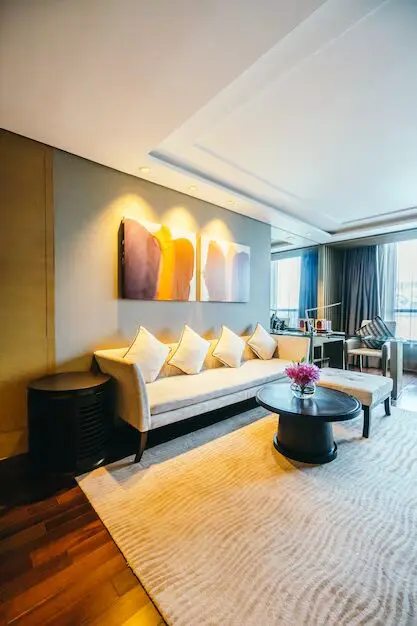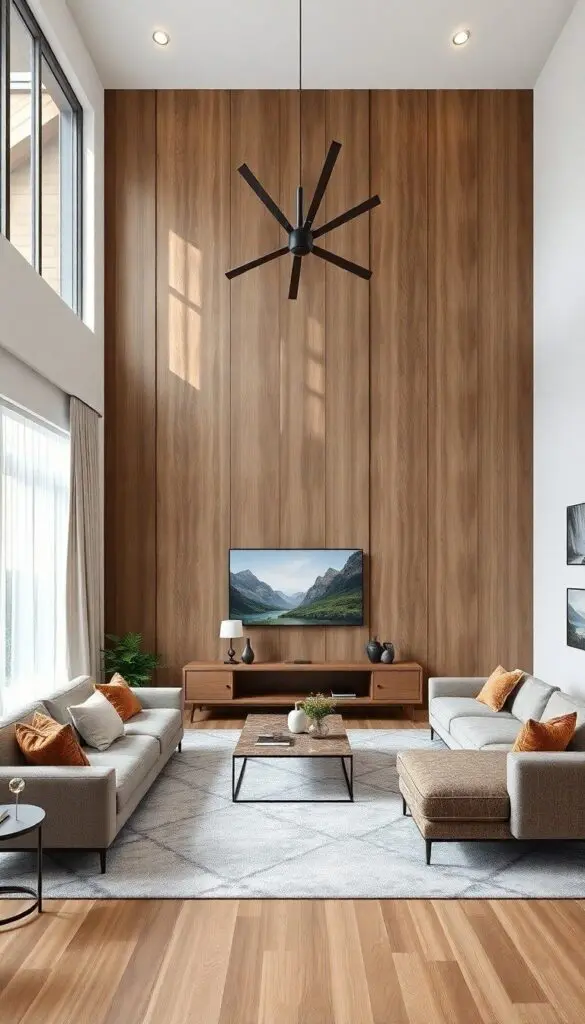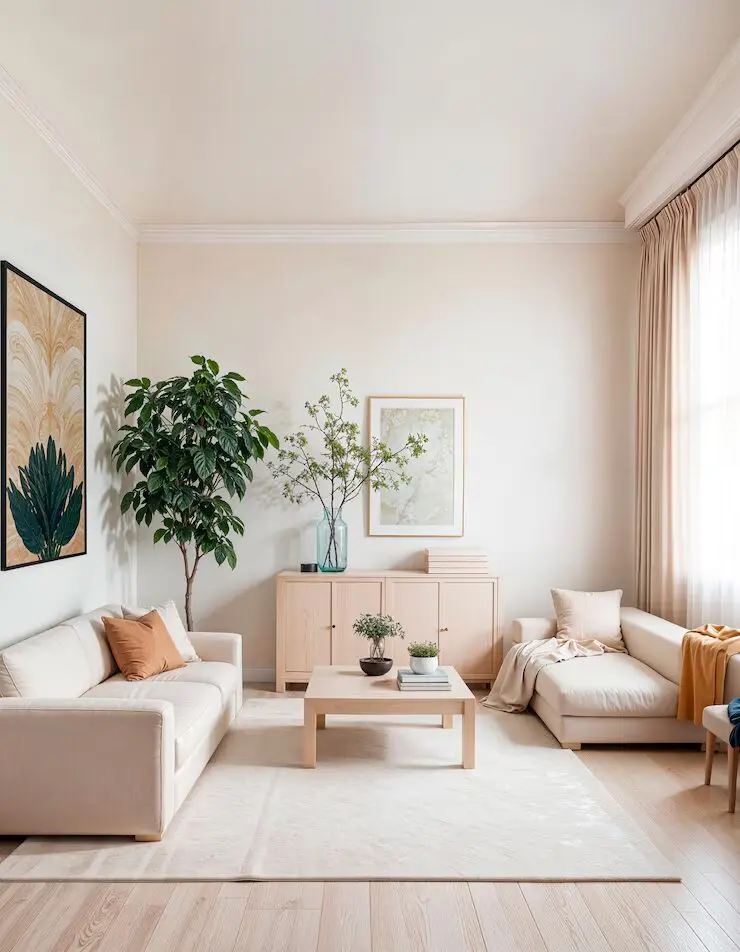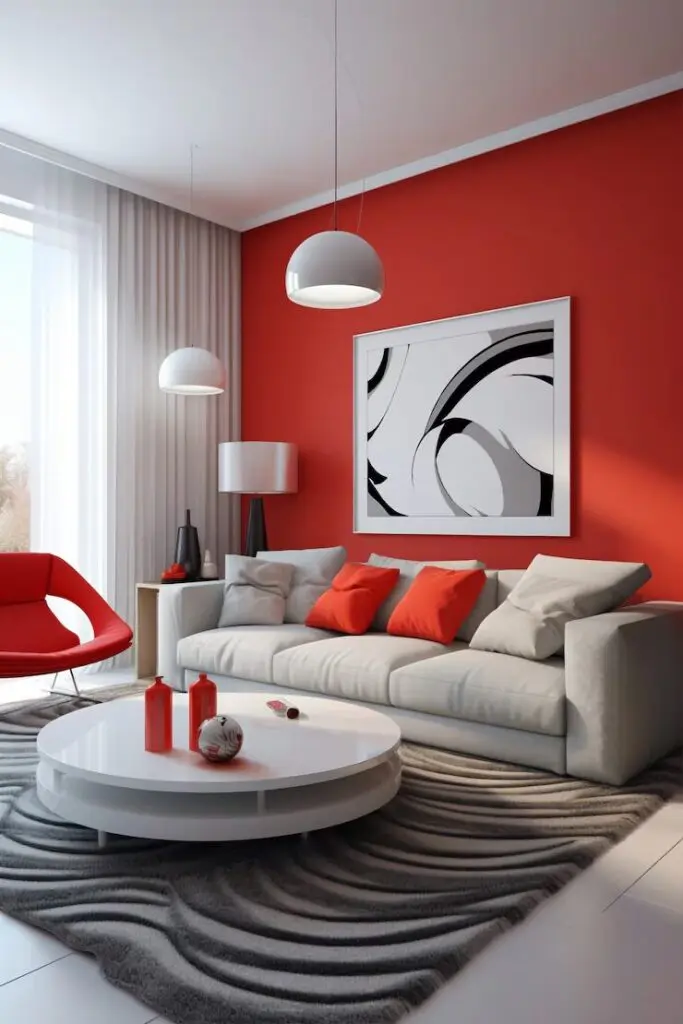
Living room layouts are essential in creating a functional and inviting space. The layout sets the tone for the entire room, determining how furniture is arranged and how the space flows. Whether you’re designing a cozy nook or a spacious open area, a well-thought-out living room layout maximizes comfort and usability. Key considerations include traffic flow, focal points like the TV or fireplace, and how to balance seating arrangements. The right layout can enhance both the style and functionality of your living room, making it a perfect space for relaxation, entertainment, and socializing.
Small Living Room Layouts

Image source: homeqly.com
Small living room layouts require careful planning to maximize space while maintaining comfort and style. The key is to arrange furniture and decor in a way that creates an open, airy atmosphere without sacrificing functionality. One effective approach is the open layout, where the furniture is arranged to avoid overcrowding and create an easy flow of movement. For example, positioning a sofa against one wall and keeping the center of the room clear allows for a more spacious, uncluttered feel.
Another popular layout is the floating furniture arrangement. Instead of pushing everything against the walls, furniture pieces like the sofa and chairs are placed in the middle of the room, creating a cozy conversation area. This layout works particularly well in open-plan spaces where the living room blends seamlessly with other areas.
Using multi-functional furniture is crucial in small living rooms. Opt for items like a storage ottoman, a sleeper sofa, or a coffee table with hidden compartments to keep the space organized and clutter-free. Vertical space should also be maximized with wall-mounted shelves, hanging plants, and tall bookcases to free up floor space.
The L-shaped layout is another excellent option for small living rooms. By placing the seating in a corner, you can create a natural division of space without the need for walls, making the room feel more expansive. Additionally, symmetry can help achieve a balanced, harmonious look, such as matching armchairs or placing equal-sized tables on either side of the room.
Ultimately, the goal of a small living room layout is to create a space that feels open, inviting, and functional, making the most of every inch while maintaining a sense of flow and comfort.

Image source: homeqly.com
Small living room layouts require thoughtful design to maximize space, comfort, and functionality. The key to a successful layout is balancing furniture placement, traffic flow, and storage while maintaining a sense of openness. One popular option is the open layout, where furniture is arranged to avoid overcrowding, with key pieces like a sofa positioned against a wall to free up floor space. This creates a more spacious and airy atmosphere.
Another effective layout is the floating furniture arrangement, where seating is placed away from walls, creating a cozy, centered conversation area. This layout works well in open-plan homes or when you want to add a sense of intimacy to a smaller space.
To optimize storage in a small living room, multi-functional furniture is essential. Consider items like storage ottomans, sleeper sofas, or coffee tables with hidden compartments to keep the room organized. Vertical space is also important—using tall bookcases, wall-mounted shelves, or hanging plants helps free up floor area.
The L-shaped layout works well in rooms with a corner, as it allows for a natural flow and maximizes seating without overpowering the space. Ultimately, a well-planned small living room layout should create a cozy, functional environment that feels open, inviting, and balanced.

Image source: homeqly.com
Large Living Room Layouts

Image source: homeqly.com
Large living room layouts offer a wealth of design opportunities, allowing for flexibility and creativity in how the space is organized. The key to an effective layout is creating distinct zones that maintain a sense of cohesion and flow, ensuring the room feels balanced without being overwhelming.
One popular approach is the open-plan layout, where furniture is arranged in a way that encourages easy movement and interaction. A central seating area, often with a large sofa and chairs, can be positioned around a focal point like a fireplace or TV, while additional seating or a reading nook can be created in another corner. This layout allows for multiple areas of activity, promoting a sense of spaciousness.
For larger rooms, consider incorporating multiple conversation areas. This can be achieved by grouping furniture in smaller sections, such as a sofa with a couple of chairs on one side and a second seating area with armchairs or a smaller couch on the other. This creates intimacy and coziness while still maintaining the open feel of the room.
Layering textures and using statement furniture pieces can help ground the space. A large rug, bold lighting, and artwork can define different sections of the room, making it feel both expansive and inviting.

Image source: homeqly.com
A large living room layout offers abundant design possibilities, allowing you to create a functional yet stylish space. The key to an effective large layout is dividing the room into distinct zones, ensuring each area feels purposeful without overcrowding the space. One popular option is the centralized seating area, where a large sofa and accompanying chairs are arranged around a focal point, like a fireplace, TV, or coffee table. This layout fosters conversation and relaxation while keeping the room organized.
For a more dynamic look, consider multiple seating zones. By incorporating smaller groupings of furniture, such as a reading nook, a conversation corner with armchairs, or a cozy lounge area, you can create an intimate feel within the larger space. This approach encourages various activities while maintaining the room’s spaciousness.
Another key aspect is the use of statement furniture and decor. Large pieces, such as oversized rugs, bold artwork, or grand lighting fixtures, help anchor the space and add character. Additionally, layering textures and incorporating different materials—like wood, metal, and fabric—adds depth and warmth.
Ultimately, a large living room layout should prioritize both functionality and aesthetics, ensuring the space feels inviting, balanced, and thoughtfully designed.

Image source: homeqly.com
A large living room layout provides endless possibilities for creating a spacious and inviting environment. The primary goal is to divide the space into functional zones that flow seamlessly while maintaining a sense of openness. One effective approach is the centralized seating area, where a large sofa is positioned with complementary armchairs around a focal point, such as a fireplace or TV. This arrangement encourages conversation and creates a cozy atmosphere within the expansive space.
To maximize functionality, consider multiple conversation areas. Smaller groupings of furniture, such as a reading nook with an armchair and floor lamp or a secondary seating area for guests, can be added without cluttering the room. This allows for various activities without diminishing the room’s openness.
The use of statement pieces is key in large living room layouts. A large rug can anchor the space, while bold artwork, sculptures, or oversized furniture can serve as focal points, creating balance. Consider layering textures, using different materials like wood, metal, and fabric, to add warmth and depth to the space.
In a large living room, scale and proportion are essential. Ensure furniture and decor are appropriately sized to complement the room’s size, keeping the space functional, comfortable, and visually appealing.
Furniture Placement

Image source: homeqly.com
Furniture placement is essential for creating a functional and visually pleasing space. The goal is to arrange furniture in a way that promotes flow, maximizes comfort, and enhances the room’s purpose. Start by identifying the focal point—whether it’s a fireplace, TV, or window—and arrange key pieces, like the sofa or chairs, to face it. Allow for clear pathways, ensuring easy movement between seating and other areas. In small spaces, opt for multi-functional furniture, while in larger rooms, consider creating separate zones for various activities. Thoughtful furniture placement can transform a room into a welcoming and well-balanced environment.

Image source: homeqly.com
Seating Arrangements

Image source: homeqly.com
Seating arrangements are crucial in creating a comfortable and inviting space. The right arrangement fosters conversation, enhances flow, and ensures the room’s functionality. For small rooms, a simple sofa with a few chairs placed around a central table can create an intimate feel. In larger spaces, consider grouping furniture into multiple zones to define areas for different activities, such as a reading nook or a conversation corner. Arrange seating around a focal point, like a TV, fireplace, or artwork, to create balance. Thoughtful seating arrangements not only improve comfort but also help in optimizing space and style.
Lighting Solutions

Image source: homeqly.com
Lighting solutions are essential for enhancing the ambiance and functionality of any space. A well-designed lighting plan incorporates multiple layers: ambient lighting provides overall illumination, task lighting focuses on specific activities like reading or cooking, and accent lighting highlights artwork or architectural features. Use a mix of ceiling lights, floor lamps, table lamps, and wall sconces to create balance and dimension. Dimmer switches and adjustable lighting fixtures allow flexibility, while natural light can be maximized with strategically placed mirrors or sheer curtains. Thoughtful lighting not only brightens a room but also sets the mood and highlights design elements.
Conclusions
In conclusion, a well-thought-out living room layout is key to creating a functional, comfortable, and stylish space. Whether you have a small or large living room, the right arrangement of furniture, seating zones, and focal points can enhance the flow and usability of the room. Thoughtful furniture placement, effective use of lighting, and incorporating multi-functional pieces can maximize space and create a harmonious atmosphere. By considering the room’s purpose, size, and personal style, you can craft a living room layout that not only meets your needs but also provides a welcoming environment for relaxation and socializing.
Related Post:
